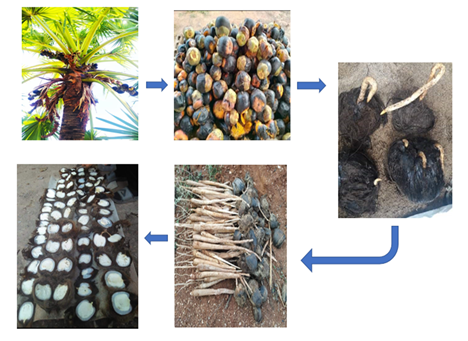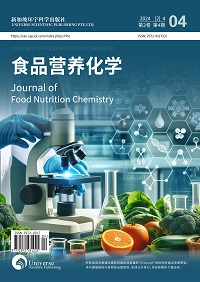深入了解亚洲扇叶树头榈(Borassus flabellifer)吸器的分子和材料及其营养价值
DOI:
https://doi.org/10.18686/zhfnc.v1i3.162关键词:
扇叶树头榈农业;亚洲扇叶树头榈;糖棕;吸器;营养品;生物材料摘要
糖棕植物在可持续发展方面具有尚未开发的潜力,其产品具有很高的食用和药用价值。扇叶树头榈农业是指种植和利用扇叶树头榈来实现自力更生和可持续发展。发芽种子的胚乳/胚胎是一种重要的生物材料,也被称为吸器。本文全面介绍了吸器的分子,特别是那些具有制药和营养价值的分子,并简要探讨了吸器的其他应用。种子发芽及其后的吸器发展的讨论已成为21世纪研究的焦点。。随着化学分析技术的进一步发展,以及人们日益认识到植物几乎每个部分的不同用途,包括吸器在内的植物部分的植物化学成分引起了更多关注。近来对吸器的研究主要探讨吸器分子、其各自的功能和用途,以及它们与外部因素的相互作用。在吸器将胚乳中的复杂营养物质转化为对生长中的胚胎有用的简单形式的过程中,它由各种必需的糖类、氨基酸、植物化学物、生物活性化合物、宏量和微量营养素组成,所有这些都对人类健康极为有益。。它还含有苷类、黄酮类、酚类和皂苷,这些物质具有抗高血压、高胆固醇血症、高血糖、肥胖症的药用特性,还能抗过敏、抗癌、抗肿瘤以及抗氧化。关于吸器的最新研究强调了其提取物如何作为一种高效的抗氧化和抗炎功能性食品。未来对扇叶树头榈吸器的研究可能提供潜在的应用,强调其在药物、营养和民族植物学方面的重要性。

##submission.downloads##
已出版
文章引用
期
栏目
执照
版权声明
CC BY-NC 4.0作者应保留其作品的版权,并授予期刊/出版商首次出版该作品的权利,同时根据以下条款获得许可: 知识共享署名-非商业性4.0国际版(CC BY-NC 4.0)。本许可证允许复制、分发和传播作品,前提是声明了原创作者的正确归属。
参考
1. McCurrach J. Palms of the World. Harper Bros; 1960.
2. Johnson D. Palms: Their Conservation and Sustained Utilization. Status Survey and Conservation Action Plan. Gland: International Union for Conservation of Nature; 1996. pp. 25–45.
3. Dransfield J. Genera Palmarum: The Evolution and Classification of Palms. Key Publishing; 2008.
4. Thevamirtha C, Monichan S, Selvakumar PM. Carbon-based materials from Borassus flabellifer and their applications. Journal of Environmental Nanotechnology 2021; 10(4): 8–12. doi: 10.13074/jent.2021.12.214445
5. Thevamirtha C, Balasubramaniyam A, Srithayalan S, et al. An insight into the antioxidant activity of the facial cream, solid soap and liquid soap made using the carotenoid extract of Palmyrah (Borassus flabellifer) fruit pulp. Industrial Crops and Products 2023; 195: 116413. doi: 10.1016/j.indcrop.2023.116413
6. Alexis Thayaparan CT, Kuldeep SA, Dewanjee S, et al. An insight into the structure and functions of flabelliferins and borassosides, nutraceuticals in Asian palm (Borassus flabellifer). Food Nutrition Chemistry 2023; 1(2): 31. doi: 10.18686/fnc.v1i2.31
7. Prasad ARB, Vignesh S, Elumalai A, et al. Nutritional and pharmacological properties of Palmyra Palm. Food and Humanity 2023; 1: 817–825. doi: 10.1016/j.foohum.2023.07.030
8. Monichan S, Thevamirtha C, Rajkumar RJ, et al. Palmyraculture: An insight into the nano medicines from Palmyra Palm (Borassus flabellifer L.). Acta Scientific Medical Sciences 2021; 5(11): 143–153.
9. Selvakumar PM, Nuzhat S, Quadrey MM, et al. Green nanomaterials: Design, synthesis, properties, and industrial applications. In: Handbook of Smart Materials, Technologies, and Devices: Applications of Industry 4.0. Springer International Publishing; 2022. pp. 1–19.
10. Varadaraju C, Selvakumar Paulraj M, Tamil Selvan G, et al. An insight into Asian Palmyra Palm fruit pulp: A fluorescent sensor for Fe2+ and Cd2+ ions. Materials Today: Proceedings 2021; 47: 747–750. doi: 10.1016/j.matpr.2020.06.532
11. Uhl NW, Dransfield J. A Classification of Palms Based on the Work of Harold E, Moore Jr. Genera Palmarum; 1987.
12. Johnson DV. Palm conservation: Its antecedents, status and needs. In: World Palm Symposium at Fairchild Tropical Botanical Garden on October. IUCN Publications Services Unit; 1995.
13. Tomlinson PB. Anatomy of the Monocotyledons, Volume 2: Palmae. Oxford University Press; 1961.
14. Mukherjee AK, Choudhury D, Bagchi P. Constitution of the galactomannan from the kernel of green Palmyra Palm nut (Borassus flabellifer linn.). Canadian Journal of Chemistry 1961; 39(7): 1408–1418. doi: 10.1139/v61-180
15. Keusch L. The mobilization of reserve mannan in the germinating date seed (German). Planta 1968; 78(4): 321–350. doi: 10.1007/bf00387091
16. Dassanayake MD, Sivakadachchan B. Germination and seedling structure of Borassus fiabellifer L. Ceylon Journal Science 1973; 10:157–166.
17. Veerasamy S. Polyembryony and twin seedlings in Borassus flabellifer L. (Palmae). Botanical Journal of the Linnean Society 1982; 85(2): 147–152. doi: 10.1111/j.1095-8339.1982.tb00590.x
18. Alang ZC, Moir GFJ, Jones LH. Composition, degradation and utilization of endosperm during germination in the oil palm (Elaeis guineensis Jacq.). Annals of Botany 1988; 61(2): 261–268. doi: 10.1093/oxfordjournals.aob.a087553
19. DeMason DA. Embryo structure and storage reserve histochemistry in the palm Washingtonia filifera. American Journal of Botany 1988; 75(3): 330–337. doi: 10.1002/j.1537-2197.1988.tb13447.x
20. DeMason DA, Sekhar KNC, Harris M. Endosperm development in the date palm (phoenix dactylifera) (arecaceae). American Journal of Botany 1989; 76(9): 1255–1265. doi: 10.1002/j.1537-2197.1989.tb15107.x
21. Viji V, Chandra R, Salim PN, Puthur JT. Germination associated morphological and anatomical changes in Coryphaumbraculifera L. seeds. Phytomorphology 2015; 65(1/2): 11–17.
22. Srivastava LM. Seed food reserves and their accumulation. Plant Growth and Development 2002; 503–520. doi: 10.1016/b978-0-12-660570-9.50178-7
23. Baskin JM, Baskin CC. What kind of seed dormancy might palms have? Seed Science Research 2013; 24(1): 17–22. doi: 10.1017/s0960258513000342
24. Srivijeindran S, Jayaweera C, Navaratnam P. Optimizing the harvesting time of Palmyrah (Borassus flabellifer) haustorium to retain its nutrient content without affecting the development of tuber. Journal of Natural Product and Plant Resources 2016; 6: 12–20.
25. Davis TA, Johnson DV. Current utilization and further development of the Palmyra Palm (Borassus flabellifer L., Arecaceae) in Tamil Nadu state, India. Economic Botany 1987; 41(2): 247–266. doi: 10.1007/bf02858972
26. Flach M, Rumawas F. Borassus flabellifer L. In: Plant Resources of South-East Asia. Backhuys Publishers; 1996. pp. 59–63.
27. Haynes J, McLaughlin J. Edible Palms and Their Uses. University of Florida; 2000.
28. Mariselvam R, Ignachimuthu SJ, Mosae PS. Review on the nutraceutical values of Borassus flabelifer Linn. Journal of Pharmaceutics and Drug Research 2020; 3: 268–271.
29. Selvakumar PM, Thanapaul RJRS. An insight into the polymeric structures in Asian Palmyra palm (Borassus flabellifer Linn). Organic Polymer Material Research 2021; 2(2). doi: 10.30564/opmr.v2i2.2639
30. Wongsinchuan N, Sirinupong M. The studies of fresh weight and nutrition composition of Palmyra Palm (Borassus flabellifer L.) haustorium at the different incubation period. Thai Agricultural Research Journal (Thailand) 2014; 32(3): 268–275.
31. Pollachat A, Wongsinchuan N, Suanphairoch S. Total phenolic contents and antioxidant activity in Palmyra Palm (Borassus flabellifer L.) haustorium at the different incubation period. In: Proceedings of 53th Kasetsart University Annual Conference; 3–6 February 2015; Bangkok. pp. 622–628.
32. Tharmaratnam G, Navaratnam P, SriVijeindran S. Preservation of Palmyrah haustorium, young fruit kernel and boiled tuber with lengthen shelf-life consisting their native characters. Annals of Biological Research 2018; 9(2): 1–10.
33. Vengaiah PC, Kumara VB, Murthy GN, Prasad KR. Physico-chemical and functional characteristics of Palmyrah (Borassus flabellifer L.) spongy haustorium flour. Journal of Nutrition and Health Science 2019; 6(1).
34. Malayil D, House NC, Puthenparambil D, et al. Borassus flabellifer haustorium extract prevents pro-oxidant mediated cell death and LPS-induced inflammation. Drug and Chemical Toxicology 2020; 45(4): 1716–1722. doi: 10.1080/01480545.2020.1858854
35. Sudhakar R, Murthy TGK, Rao CC, et al. Entrepreneurship in Palmyrah Fibre. Central Tobacco Research Institute (ICAR); 2012.
36. Sankaralingam A, Hemalatha G, Ali AM. A Treatise on Palmyrah. All India Coordianated Research Project on Palms, Agricultural College and Research Institute, Tamil Nadu Agricultural University and Central Plantation Crops Research Institute, Indian Council of Agricultural Research; 1999.
37. Srivastava A, Bishnoi SK, Sarkar PK. Value addition in Palmyra Palm (Borassus flabellifer L.): A potential strategy for livelihood security and poverty alleviation. Rashtriya Krishi 2017a; 12(1): 110–112.
38. Srivastava A, Bishnoi SK, Sarkar PK. Value addition in minor fruits of eastern India: An opportunity to generate rural employment. In: Dutta AK, Mondal B (editors). Fruits for Livelihood: Production Technology and Management Practices. Agrobios (India); 2017. pp. 395–417.
39. Krishnaveni TRS, Arunachalam R, Chandrakumar M, et al. Potential review on Palmyra (Borassus flabellifer L.). Advances in Research 2020; 21(9): 29–40. doi: 10.9734/air/2020/v21i930229
40. Saranya P. Characterization of Palmyra Fruit Borassusflabelliferlinn Pulp and Development of Ready to Serve Beverage from Palmyra Fruit Pulp [PhD thesis]. Periyar University; 2016.
41. Vengaiah P, Kaleemullah S, Madhava M, et al. Palmyrah fruit (Borassus flabellifer L.): Source of immunity and healthy food: A review. The Pharma Innovation Journal 2021; 10(11): 1920–1925.
42. Jeyaratnam M. Studies on the Chemistry and Biochemistry of Palmyrah Products [PhD thesis]. University of Jaffna; 1986.
43. Jansz ER, Wickremasekara NT, Sumuduni KAV. A review of the chemistry and biochemistry of seed shoot flour and fruit pulp of the Palmyrah Palm (Borassus flabellifer L). Journal of the National Science Foundation of Sri Lanka 2002; 30(1–2): 61. doi: 10.4038/jnsfsr.v30i1-2.2562
44. Naguleswaran S, Vasanthan T, Hoover R, et al. Structure and physicochemical properties of Palmyrah (Borassus flabellifer L.) seed-shoot starch grown in Sri Lanka. Food Chemistry 2010; 118(3): 634–640. doi: 10.1016/j.foodchem.2009.05.046
45. Prasad ARB, Arunkumar A, Vignesh S, et al. Exploring the nutritional profiling and health benefits of Palmyra Palm haustorium. South African Journal of Botany 2022; 151: 228–237. doi: 10.1016/j.sajb.2022.01.027
46. Breyer-Brandwijk MG, Watt JM. The Medicinal and Poisonous Plants of Southern and Eastern Africa being an Account of their Medicinal and other Uses, Chemical Composition, Pharmacological Effects and Toxicology in Man and Animal. E & S Livingstone Ltd; 1962.
47. Robards K, Prenzler PD, Tucker G, et al. Phenolic compounds and their role in oxidative processes in fruits. Food Chemistry 1999; 66(4): 401–436.
48. Manilal KS, Remesh M. An analysis of the data on the medicinal plants recorded in Hortus Malabaricus. Samagra: CRIKSC Journal 2009; 5&6.
49. Vijayakumari B, Vengaiah PC, Kiranmayi P. Qualitative phytochemical screening, GC-MS analysis and antibacterial activity of Palmyra fruit pulp (Borassus flabellifer L.). International Journal of Pharma and Bio Sciences 2015; 6(2): 430–435.
50. Gonsalves J. Economics Botany and Ethnobotany. International Scientific Publishing Academy; 2010.


